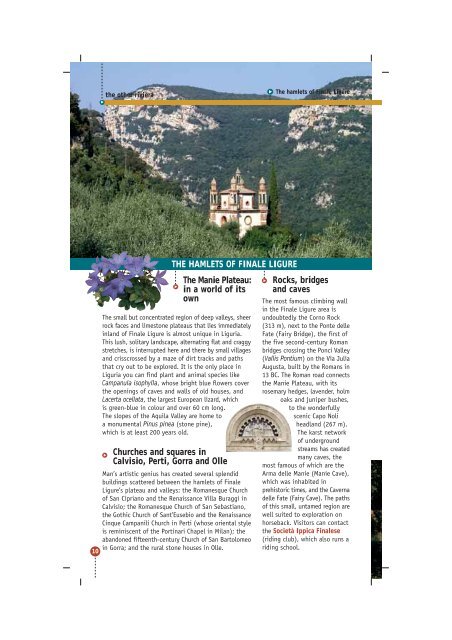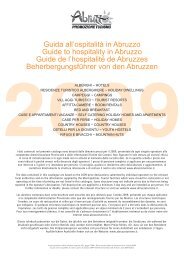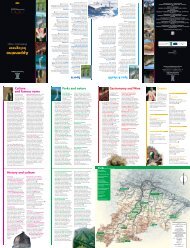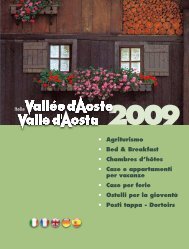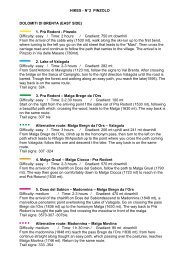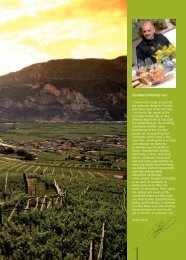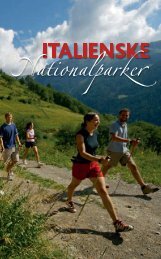A stone's throw from the sea
A stone's throw from the sea
A stone's throw from the sea
You also want an ePaper? Increase the reach of your titles
YUMPU automatically turns print PDFs into web optimized ePapers that Google loves.
<strong>the</strong> o<strong>the</strong>r riviera<br />
The hamlets of Finale Ligure<br />
THE HAMLETS OF FINALE LIGURE<br />
10<br />
The Manie Plateau:<br />
in a world of its<br />
own<br />
The small but concentrated region of deep valleys, sheer<br />
rock faces and limestone plateaus that lies immediately<br />
inland of Finale Ligure is almost unique in Liguria.<br />
This lush, solitary landscape, alternating flat and craggy<br />
stretches, is interrupted here and <strong>the</strong>re by small villages<br />
and crisscrossed by a maze of dirt tracks and paths<br />
that cry out to be explored. It is <strong>the</strong> only place in<br />
Liguria you can find plant and animal species like<br />
Campanula isophylla, whose bright blue flowers cover<br />
<strong>the</strong> openings of caves and walls of old houses, and<br />
Lacerta ocellata, <strong>the</strong> largest European lizard, which<br />
is green-blue in colour and over 60 cm long.<br />
The slopes of <strong>the</strong> Aquila Valley are home to<br />
a monumental Pinus pinea (stone pine),<br />
which is at least 200 years old.<br />
Churches and squares in<br />
Calvisio, Perti, Gorra and Olle<br />
Man’s artistic genius has created several splendid<br />
buildings scattered between <strong>the</strong> hamlets of Finale<br />
Ligure’s plateau and valleys: <strong>the</strong> Romanesque Church<br />
of San Cipriano and <strong>the</strong> Renaissance Villa Buraggi in<br />
Calvisio; <strong>the</strong> Romanesque Church of San Sebastiano,<br />
<strong>the</strong> Gothic Church of Sant’Eusebio and <strong>the</strong> Renaissance<br />
Cinque Campanili Church in Perti (whose oriental style<br />
is reminiscent of <strong>the</strong> Portinari Chapel in Milan); <strong>the</strong><br />
abandoned fifteenth-century Church of San Bartolomeo<br />
in Gorra; and <strong>the</strong> rural stone houses in Olle.<br />
Rocks, bridges<br />
and caves<br />
The most famous climbing wall<br />
in <strong>the</strong> Finale Ligure area is<br />
undoubtedly <strong>the</strong> Corno Rock<br />
(313 m), next to <strong>the</strong> Ponte delle<br />
Fate (Fairy Bridge), <strong>the</strong> first of<br />
<strong>the</strong> five second-century Roman<br />
bridges crossing <strong>the</strong> Ponci Valley<br />
(Vallis Pontium) on <strong>the</strong> Via Julia<br />
Augusta, built by <strong>the</strong> Romans in<br />
13 BC. The Roman road connects<br />
<strong>the</strong> Manie Plateau, with its<br />
rosemary hedges, lavender, holm<br />
oaks and juniper bushes,<br />
to <strong>the</strong> wonderfully<br />
scenic Capo Noli<br />
headland (267 m).<br />
The karst network<br />
of underground<br />
streams has created<br />
many caves, <strong>the</strong><br />
most famous of which are <strong>the</strong><br />
Arma delle Manie (Manie Cave),<br />
which was inhabited in<br />
prehistoric times, and <strong>the</strong> Caverna<br />
delle Fate (Fairy Cave). The paths<br />
of this small, untamed region are<br />
well suited to exploration on<br />
horseback. Visitors can contact<br />
<strong>the</strong> Società Ippica Finalese<br />
(riding club), which also runs a<br />
riding school.


